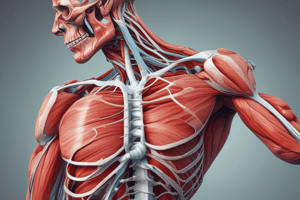Podcast
Questions and Answers
What is the primary function of muscle tissue?
What is the primary function of muscle tissue?
- Protection of internal organs
- Production of hormones
- Generating movement and maintaining position (correct)
- Storage of energy
Which component is regarded as the basic structural unit of a muscle?
Which component is regarded as the basic structural unit of a muscle?
- Muscle fibre
- Myofibril
- Tendon
- Sarcomere (correct)
What percentage of a person's weight is accounted for by muscle?
What percentage of a person's weight is accounted for by muscle?
- 20%
- 50%
- 30%
- 40% (correct)
How do muscle cells primarily generate the energy needed for their actions?
How do muscle cells primarily generate the energy needed for their actions?
Which of the following is NOT a function of muscle tissue?
Which of the following is NOT a function of muscle tissue?
What type of lever system is primarily involved in generating muscular effort to overcome a load?
What type of lever system is primarily involved in generating muscular effort to overcome a load?
Which property of muscle allows it to maintain posture and tone?
Which property of muscle allows it to maintain posture and tone?
In what way do myofibrils contribute to muscle function?
In what way do myofibrils contribute to muscle function?
Flashcards
Primary function of muscle tissue?
Primary function of muscle tissue?
Generating movement and maintaining position of the body.
What is a Sarcomere?
What is a Sarcomere?
The basic structural and functional unit of a muscle, responsible for contraction.
Muscle tissue weight percentage?
Muscle tissue weight percentage?
Muscle accounts for approximately 40% of a person's body weight.
Energy source for muscle cells?
Energy source for muscle cells?
Signup and view all the flashcards
Lever system order for muscle effort?
Lever system order for muscle effort?
Signup and view all the flashcards
Muscle property for posture?
Muscle property for posture?
Signup and view all the flashcards
Myofibrils function?
Myofibrils function?
Signup and view all the flashcards
Study Notes
Muscle Overview
- Muscle accounts for approximately 40% of a person's weight.
- Definition: A band of fibrous tissue in the body that contracts, producing movement or maintaining position.
Muscle Tissue Structure
- Muscle tissue consists of muscle cells containing myofibrils.
- Myofibrils are contractile threads extending through muscle fibers.
- Sarcomeres are the basic structural units of muscle, composed of long fibrous proteins that slide to create dark and light bands.
Muscle Energy Source
- Muscle cells utilize Adenosine Triphosphate (ATP) as their primary energy source.
- ATP is generated through the metabolism of food into chemical energy.
Functions of Muscle
- Key functions include:
- Maintaining posture and muscle tone
- Facilitating digestion and circulation
- Enabling mobility and movement
- Regulating temperature and producing heat
- Providing organ protection and aiding in urination and respiration
Movement Mechanics
- Lever systems coordinate bones and muscles for movement.
- Types of levers:
- First Order Lever: Generates muscular effort to overcome loads or increases movement speed.
- Second Order Lever: Focuses on load overcoming.
- Third Order Lever: Enhances the speed of movements.
Heat Regulation
- Maintaining a constant body temperature is vital for healthy survival and is facilitated by muscle function.
Studying That Suits You
Use AI to generate personalized quizzes and flashcards to suit your learning preferences.




